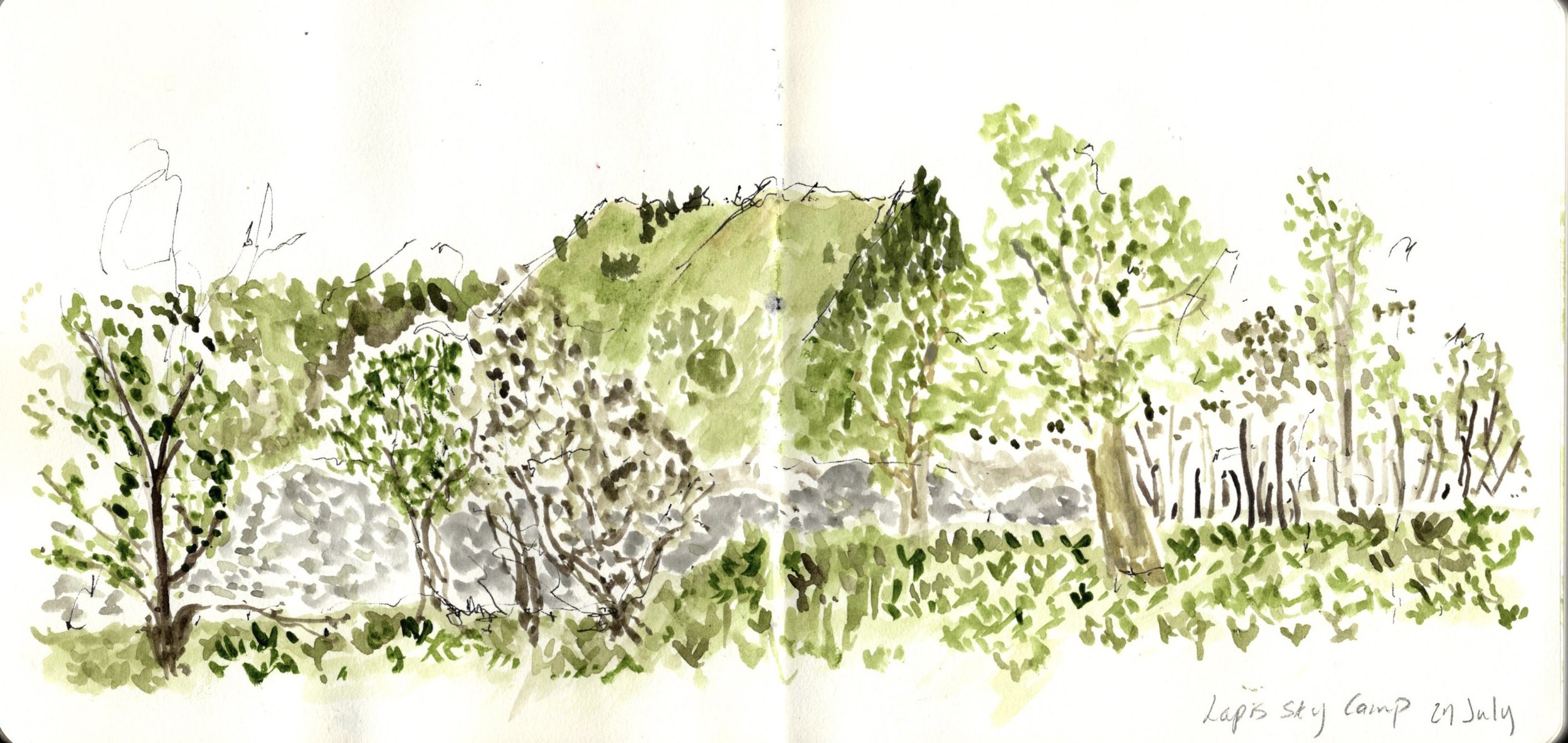A story of art and identity : Christine Chang Hanway Q&A
We had the privilege of sitting down with Christine Chang Hanway in her home, where she reflected on her recent journey with Tengri to Mongolia’s remote Khangai Mountains – a trip that deepened her connection to her heritage and reshaped her artistic perspective. In this Q&A, Christine shares how the landscape, nomadic traditions, and her pursuit of flow have profoundly transformed her life and art.
Christine Chang Hanway. ©Kenneth Lam
Thank you for being Tengri’s first ‘artist in residence’. Tell us little about yourself and your journey as an artist.
Thank you for having me! My favourite definition of an artist is ‘one who creates’. Living itself is a creative act, making artists of us all. I am a visual artist who tells stories through my drawings and paintings. Growing up as a first-generation Chinese immigrant in the suburbs of post-war New England, I often crafted narratives to make sense of who I was. To reconcile my love for spaghetti and wanting to be Italian with my Chinese heritage, I convinced myself that I was a direct descendant of Marco Polo, much to my parents’ bewilderment.
I was happiest when I was drawing, painting, crafting and reading. I pursued architecture in university because I thought it was a practical outlet for my artistic inclinations. And as an architect, I found joy in designing museums and exhibitions as they allowed me to tell stories through space. Now, as I focus on being a visual artist, I realise I am still immersed in storytelling.
Valley of the Ancestors © Christine Chang Hanway
What drew you to join Tengri's journey to the Khangai Mountains?
I have always been drawn to Mongolia because one of my other favourite narratives was that I was a Mongolian princess. Both of my parents left a lot of their history behind when they immigrated to the United States from China during the Civil War. With only a few fragments of information — like my grandfather was from Inner Mongolia — I created stories to shape my identity. In the years before Mulan and Disney, I was searching for female role models who resembled me.
I was compelled to join Tengri’s journey to the Khangai Mountains due to your experiences working with the yak herders over the last ten years. Your dedication to helping them sustain their way of life made me curious and I wanted to understand the inspiration behind it.
‘Dragon’ © Christine Chang Hanway
Can you share a moment from the trip that profoundly affected you and your creative work?
Our base camp was nestled in a valley surrounded by mountains with a stream running through it. Each morning, I would watch the yak herders fly through the valley on their horses, driving their animals to grazing plains. And then in the evenings, they would soar out of nowhere from the opposite direction, bringing their animals home for the night.
The way they rode their horses, completely in tune with themselves and their surroundings, was a sight unlike any I had ever seen. Their effortless flow state was intoxicating and I yearned for that experience. In that moment, I resolved to seek more instances of flow in my own life.
Over the past few months, I’ve been practising Qi Gong, which has significantly reminded me that our energy and creativity are deeply rooted in nature. This realisation has transformed my perspective on creativity. Drawing used to be my sole pathway to achieving a flow state and I have now come to understand that I can incorporate it into every aspect of my daily life. Imagine being able to access that state of flow whenever you wish — Qi Gong teaches you how to do that.
Flow of the Tamir River © Christine Chang Hanway
How have the landscape and culture of the remote Khangai Mountains, yaks and herders influenced you?
I will never forget our approach to our base camp. We’d been driving along unpaved, bumpy dirt roads for about two hours and as it got more and more remote, a guide appeared on a motorcycle out of nowhere and showed us the rest of the way. He led us to a cliff’s edge before stopping to show us the most fantastical view of the valley below where our base camp was. It felt like a scene from Shang-Chi and the Legend of the Ten Rings; like we were about to enter another world and come out changed forever. Over the next few days as we lived with the herders, I began to understand how their concept of ‘home’ was very different to mine. The portable gers they sleep and eat in are mere white dots around which their animals grazed and rested. Instead, it’s the expansive landscape all around that is home to the herders, and they are always connected to it.
Lapis Sky Camp © Christine Chang Hanway
What do you think makes traveling to remote, untouched places so valuable in today's fast-paced world?
In today’s fast-paced world, we tend to disconnect from nature and the world around us without even realising it. We disconnect further when we live in our heads, separated from our bodies and feelings. Traveling to remote, untouched places reminds us of who we are and how we are connected to nature, the universe, and to each other.
How did experiencing the local communities shape your perception of sustainability and tradition, as well as your own identity?
In 1924, at the age of 18, my grandfather travelled solo on horseback from Inner Mongolia to the Whampoa Military Academy in Guangdong – a thousand-mile trek across China that would have taken about a month. As the mother of two sons, I have often wondered how he navigated such an ambitious journey on his own.
The local communities we met in the Khanghai Mountains welcomed us into their homes, offering intimate glimpses of their traditional nomadic lifestyles. Their deep connection to the land and their sustainable practices revealed that my grandfather’s accomplishment wasn’t just about individual determination. It was rooted in generational knowledge of living in harmony with the environment. I gained a deeper appreciation for my cultural heritage and how traditional ecological wisdom continues to shape my identity as a mother and mentor for the next generation.
Ovoo on Mandal Mountain © Christine Chang Hanway
What elements of the trip will stay with you? Any particularly memorable moments?
The underlying spirituality of Mongolians, especially the nomadic herders, will always stay with me. Their survival depends on their relationship with nature, which is built on respecting and understanding it. And most importantly, adapting to it.
I was particularly moved by the Ovoos (shrines with Shamanistic origins built from rocks or wood). Dotted along the roads and landscape, they are a constant reminder to stay in the present and honour what is around you. Mongolians have been worshipping at these shrines for thousands of years and we often stopped in our journey to perform small rituals when we came upon one. These moments of quiet ritual amid Mongolia's vast expanses became the heartbeat of my journey.
And of course, in ‘Lessons Learned from the Shaman Next Door’, I write about a particularly meaningful experience!
What would you say to someone considering this journey but unsure about exploring remote destinations and a different culture and community?
Traveling in Mongolia requires a suspension of one’s normal expectations. The uncertainty of being in a remote destination can be daunting. Plans can change quickly in line with the circumstances and you never quite know how things will turn out. But sometimes, you just have to take a deep breath and go for it because the experience will be like nothing you have encountered before. You will surprise yourself with how quickly you can adapt, which is quite empowering.
Horse riding in the Khangai Mountains. © Alimaa Baramsaldorj
Anything else you'd like to share with our readers?
Thank you again, Nancy and Tengri, for an incredible experience. Your knowledge and passion of Mongolian people and culture were invaluable. The sacred reverence the nomadic herders have for the world around them is embodied in their devotion to their yaks. And whenever I wear my Tengri cardigan made from yak fibres, I think of the peaceful, physical presence of the animals on the land and I am immediately transported back to the Khangai Mountains.
Christine wearing a custom knitted cardigan and wrapped in Noyon blanket and Herringbone yak fabric. ©Kenneth Lam
Thank you, Christine, for inviting us into your home and sharing your inspiring journey to Mongolia’s Khangai Mountains. To delve deeper into Christine’s transformative experiences in Mongolia, we invite you to explore her visual essay, Lessons from the Shaman Next Door, available on xoXotine.com.









